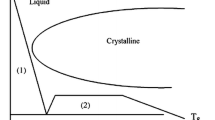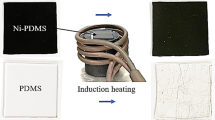Abstract
Micro/Nano imprinting or hot embossing is currently a target of interest for industrial production of micro and Nano devices for the low cost aspect. In Fluidic MEMS (Micro Electromechanical Systems) applications, polymer materials have been widely employed for their low cost to fabricate the economical products (Becker and Heim in Sens Acuators A 83:120–135, 2000; Becker and Gaertner in Mol Biotechnol 82:89–99, 2001). However glasses are much more suitable for the higher temperature applications or under the stronger chemical environments. Moreover UV absorption of glass materials is much less than that of polymers, which is the advantage for bio-analysis. In Optical MEMS as well, glasses are good candidate materials for the better optical properties, such as high refractive index, low UV absorption and others. Although wet etching of glasses is widely employed for fabrication of fluidic MEMS devices, the wet etching is not satisfactory for the low machining resolution, the isotropic etched profile and poor roughness of the fabricated structures. Dry etching of glasses is then an alternative for Micro/Nano structuring, but the etching rate is extremely low (order of 0.1 μm/min) and the cost is too high because of the expensive RIE (Reactive Ion Etching) facility. Above mentioned is the reason why we are interested in hot embossing or imprinting of glasses of Micro/Nano scale. In our previous study, Micro/Nano imprinting was developed for Pyrex glasses using GC (Glassy Carbon) mold prepared by FIB machining (Takahashi et al. in Symposium on DTIP 2004 pp 441–446, 2004). The disadvantage of FIB machining is limited area of etching. The typical area of FIB is less than several hundreds micrometer square. This is the reason why we tried the large area of embossing using GC mold fabricated by dicing machine. Micro hot embossed test structures were successfully demonstrated with good fidelity. Fabricated micro structures can be applied for fabrication of microchamber array for PCR (Akagi et al. in Sci Techol Adv Mater 5:343–349, 2004; Nagai et al. in Anal Chem 73:1043–1047, 2001).











Similar content being viewed by others
References
Akagi Y, Rao SR, Morita Y, Tamiya E (2004) Optimization of fluorescent cell-based assays for high-throughput analysis using microchamber array chip formats. Sci Techol Adv Mater 5:343–349
Hirai Y, Fujiwara M, Okuno T, Tanaka Y, Endo M, Irie S, Nakagawa K, Sasago M (2001) J Vac Sci Technol B 19:2811
Holger Becker, Claudia Gaertner (2001) Polymer based micro reactor. Mol Biotechnol 82:89–99
Holger Becker, Ulf Heim (2000) Hot embossing as a method for the fabrication of polymer high aspect ratio structures. Sens Actuators A 83:120–135
Itou K, Sugimoto K (2003) Proceedings of the Japan Society precision engineering conference, C26, Spring 2003, pp 111
Li X, Abe T, Liu Y, Esashi M (2001) Proceedings MEMS 2001, Interlaken 98
Masaharu Takahashi, Yoichi Murakoshi, Kohichi Sugimoto, Ryutaro Maeda (2004) Micro/Nano hot embossing pyrex glass with glassy carbon mold fabricated by focused-ion beam etching. In: Symposium on DTIP 2004, pp 441–446
Miyamoto I (1995) J Jpn Soc Technol Plastic 36(411):307
Nagai H, Murakami Y, Morita Y, Yokoyama K, Tamiya E (2001) Development of a microchamber array for picoliter PCR. Anal Chem 73:1043–1047
Shan XC, Maeda R, Murakoshi Y (2002) Proceedings SPIE 4936, pp 67
Umetani M (1995) J Jpn Soc Technol Plastic 36(411):350
Author information
Authors and Affiliations
Corresponding author
Rights and permissions
About this article
Cite this article
Takahashi, M., Murakoshi, Y., Maeda, R. et al. Large area micro hot embossing of Pyrex glass with GC mold machined by dicing. Microsyst Technol 13, 379–384 (2007). https://doi.org/10.1007/s00542-006-0186-z
Received:
Accepted:
Published:
Issue Date:
DOI: https://doi.org/10.1007/s00542-006-0186-z




